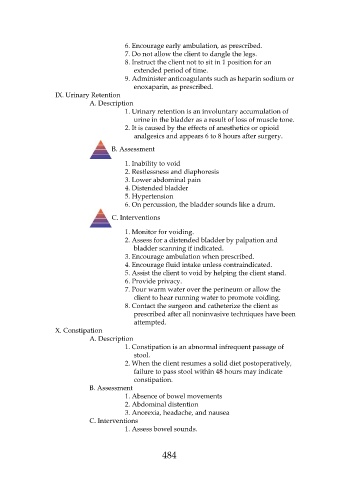Page 484 - Saunders Comprehensive Review For NCLEX-RN
P. 484
6. Encourage early ambulation, as prescribed.
7. Do not allow the client to dangle the legs.
8. Instruct the client not to sit in 1 position for an
extended period of time.
9. Administer anticoagulants such as heparin sodium or
enoxaparin, as prescribed.
IX. Urinary Retention
A. Description
1. Urinary retention is an involuntary accumulation of
urine in the bladder as a result of loss of muscle tone.
2. It is caused by the effects of anesthetics or opioid
analgesics and appears 6 to 8 hours after surgery.
B. Assessment
1. Inability to void
2. Restlessness and diaphoresis
3. Lower abdominal pain
4. Distended bladder
5. Hypertension
6. On percussion, the bladder sounds like a drum.
C. Interventions
1. Monitor for voiding.
2. Assess for a distended bladder by palpation and
bladder scanning if indicated.
3. Encourage ambulation when prescribed.
4. Encourage fluid intake unless contraindicated.
5. Assist the client to void by helping the client stand.
6. Provide privacy.
7. Pour warm water over the perineum or allow the
client to hear running water to promote voiding.
8. Contact the surgeon and catheterize the client as
prescribed after all noninvasive techniques have been
attempted.
X. Constipation
A. Description
1. Constipation is an abnormal infrequent passage of
stool.
2. When the client resumes a solid diet postoperatively,
failure to pass stool within 48 hours may indicate
constipation.
B. Assessment
1. Absence of bowel movements
2. Abdominal distention
3. Anorexia, headache, and nausea
C. Interventions
1. Assess bowel sounds.
484

